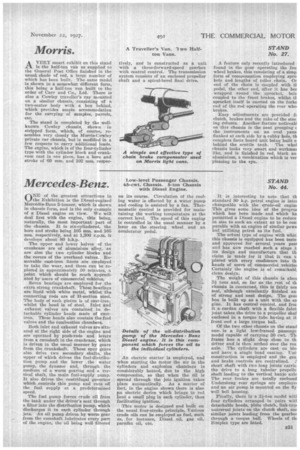Mercedes-Benz.
Page 155

If you've noticed an error in this article please click here to report it so we can fix it.
ONE of the greatest attractions in the Exhibition is the Diesel-engined Mercedes-Bens 5-tonner, which is shown in chassis form, and is the only example of a Diesel engine on view. We will deal first with the engine, this being, naturally, the most important part of the chassis. It is six-cylindered, the bore and stroke being 105 mm. and 165 mm. respectively, and at 1,300 r.p.m. it develops about 80 b.h.p.
The upper and lower halves of the crankcase are of aluminium alloy, as are also the two cylinder blocks and the covers of the overhead valves. Removable cast-iron liners are employed to take the wear, and these can be replaced in approximately 30 minutes, a point which should be much appreciated by users of commercial vehicles.
Seven bearings are employed for the extra strong crankshaft. These bearings are lined with white metal, whilst the connecting rods are of H-section steel. The body of each piston is of cast-iron, whilst the head is of steel. Inlet and exhaust valves are contained in detachable cylinder heads made of castiron. These heads also contain the fuel :valves and the combustion chambers.
Roth inlet and exhaust Valves are situated at the right side of the engine and are operated by push-rods and levers from a camshaft in the crankcase, which is driven in the usual manner by gears from the crankshaft. These spur gears also drive two secondary shafts, the upper of :which drives the fuel-distribution pump and the lower the water pump, the dynamo and, through the medium of a worm gearing and a vertical shaft, the main fuel-supply pump. It also drives the centrifugal governor which ,control a this pump and cuts off the fuel supply at a predetermined speed.
The fuel pump forces crude oil from the tank under the driver's seat through a filter into the distribution pump, which 'discharges it to each cylinder through jets. An oil pump driven by worm gear from the camshaft lubricates every part of the engine, the oil being well filtered on its course. Circulation of the cooling water is effected by a water pump and cooling is assisted by a fan. Thermostatic control is provided for maintaining the working temperature at the correct level. The speed of this engime is controlled in the usual manner by a lever on the steering wheel and an accelerator pedal.
An electric starter is employed, and when starting the motor the air in the cylinders and explosion chambers is considerably heated, due to the high compression, so that when the oil is spread through the jets ignition takes Place automatically. As a matter of fact, in the engine shown there is also in electric device which brings to red heat a small plug in each cylinder, thus facilitating ignition.
This motor is designed and built on the usual four-stroke principle. Various crude oils can be employed as fuel, such as, for instance, Diesel oil, gas oil, paraffin oil, etc.
It is interesting to note that th standard 80 h.p. petrol engine is intei changeable with the crude-oil engin( This gives some idea of the progres which has been made and which ha permitted a Diesel engine to be reduce in size to such an extent as to be con parable with an engine of similar powe but utilizing petrol as its fuel.
The actual type of engine with whic: this chassis is equipped has been teste. and approved for several years pear and has now reached such a stage ii its design and manufacture that th claim is made for it that it can t placed with every confidence into th hands of users of commercial vehicles Certainly the engine is of remarkabl; clean design.
The weight of this chassis is alma 3i tons and, so far as the rest of th chassis is concerned, this is fairly nor real, although excellently finished an of strong and neat design. The gem box is built up as a unit with the en gine. It has central control, and fret it a card= shaft with a flexible fabri joint takes the drive to a propeller shaf enclosed in a torque tube having at it front end a large torque ball.
Of the two other chassis on the stand ones. is a light low-framed passenge model capable of carrying 30 cwt. Th, frame has a slight drop close to th, driver and is then arched over the rea axle. The cylinders are cast en Isla and have a single bead casting. IMF construction is employed and the gea and brake controls are centralized. 2 shut shaft with two long joints Carrie. the drive to a long tubular propelle shaft leading to the vertical banjo axle The rear brakes are totally enclosed Underslung rear springs are employed and an air pump is mounted on the fly well bell housing.
Finally, there is a 34-ton model witl four cylinders arranged in pairs witl detachable heads, plate clutch, linkstypd universal joints on the clutch shaft, am similar joints leading from the gearboz through a torque ball. Wheels of du Simplex type are fitted.


















































































































































































































































































































